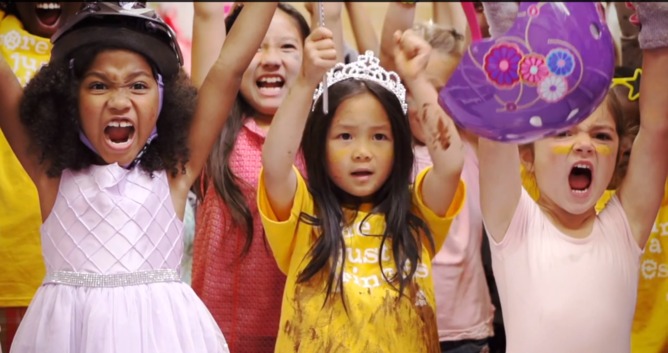There’s no good reason to push pink toys on girls
The royal family are set to be inundated with gifts once William and Kate’s child is born. But before buying presents, should people wait and see if the baby is a boy or a girl? Here is a guest blog post by Melissa Hines, Professor of Psychology, University of Cambridge, a specialist in child gender roles, who says there is no real reason for the pink and blue divide.
You only have to walk down the aisle of a toy shop to see that young girls really love pink. This has some parents worried. They are concerned that pink is bad for their daughters.
One engineer in the US is so frustrated with pink toys for girls that she has founded her own toy company that encourages girls to embrace the skills associated with engineering. A video by the company last week shows an army of young girls storming the “pink aisle” of a toy shop.
As a neuroscientist, I’m interested why certain toys are embraced by different genders. Why do girls embrace pink dolls, while boys play with vehicles of pretty much any colour, as long as it is not pink? The answers reveal both how humans develop, and how societal pressures act upon children.
Inborn preferences
The gendered preference for dolls versus trucks seems to have an inborn element. Male and female fetuses develop in somewhat different hormone environments, and this influences their later toy preferences. The testes of male fetuses begin producing testosterone at about week eight of gestation, whereas female fetuses’ ovaries do not. Consequently, male fetuses have higher levels of testosterone.
Girls with a disorder that causes their adrenal glands to produce high levels of testosterone choose to play with toys like vehicles and other boys’ toys more than other girls do, and they are less interested in dolls and other girls’ toys.
Similarly, normal variability in testosterone in infancy relates to later toy preferences. Testosterone measured in the urine of typically developing infants at ages one to six months predicts gendered behaviour, including interest in dolls and trains. Even monkeys show gender based toy preferences similar to those seen in children. If given sex-typed toys, female monkeys spend more time with the girls’ toys, and male monkeys spend more time with the boys’ toys.
It is not too surprising that female monkeys like dolls, given that they give birth and do most of the parental caring. Why would a male monkey choose a car though? The theory is that testosterone influences brain development to increase interest in vehicles, and that this is part of our evolutionary history, even though this history occurred before cars existed. These findings have led people to rethink the role of toys in children’s development.

Rose-coloured glasses
What are the fundamental properties of sex-typed toys that make them differentially interesting to girls versus boys? It does not seem to be colour or shape, because infants of both sexes like reddish colors and rounded shapes more than they like bluish colors and angular shapes. We are now trying to determine if boys like toy vehicles, because they like to watch things moving in space.
Pink is a different story. The sex-typed preference for pink emerges after preferences for dolls and vehicles. Babies aged 12-24 months already show sex-typed toy preferences, with girls showing greater interest in dolls and boys showing greater interest in cars. At this age, however, both girls and boys prefer pink and red over blue. Girls’ preference for pink emerges at about the age of three years, and could be acquired socially as adult colour preferences are.
Because girls spend their early years playing with pink toys, and enjoying these toys, they may come to like pink. The age at which a preference for pink emerges also coincides with children’s acquisition of the understanding that they are girls or boys. At about this age, they are searching for information about what people of their own gender do and like. Girls see that girls like pink and that they like to play with dolls. So they adopt gendered toy preferences, as well as colour preferences.
Toying with kids’ futures
Children are also influenced by social reinforcement encouraging gendered behaviour. Parents, peers, teachers and strangers respond differently to girls and boys when they choose to play with dolls or vehicles, or choose things that are pink. Just think of the different reactions to a child playing with a doll if he was a boy, rather than a girl. These patterns of reinforcement apply particularly to boys, who are steered away from girlish things.
Girls outgrow pink, and, in adulthood, both men and women prefer blue to pink. What harm might the gender segregation of pink and pink things in early childhood have done though? Toys provide learning opportunities for children. Playing with dolls and other girls’ toys, such as tea sets, is thought to foster the development of verbal and social skills.
Later in life, females outperform males on tests of writing ability. Perhaps steering boys away from girls’ toys, by colouring them pink and ridiculing boys for playing with them, denies them important learning opportunities. Similarly, toy cars may foster the acquisition of spatial skills that males excel at, but if pink is for girls and these toys are not pink, girls may lose these learning opportunities.
Boys gravitate toward cars, whereas girls gravitate toward dolls, and this is a product of nature as well as nurture. We can’t do much about the nature bit, but we can change nurture.
Colour coding toys to limit their appeal to both sexes nurtures limitation rather than possibility. Parents are right to be worried about the obsession with pink for girls.
Melissa Hines receives or has received funding from the United States Public Health Service, National Institutes of Health, the ESRC and the Wellcome Trust.
![]()
This article was originally published at The Conversation.
Read the original article.
